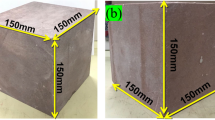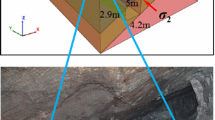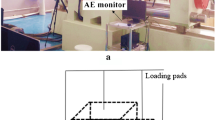Abstract
The mechanical behavior of deep rock pillars is closely related to the coupling effect of the initial high stress and the excavation-unloading process. In this study, the failure and strength characteristics of rock pillars are studied under triaxial unloading paths of three-dimensional (3D) initial high stress followed by two-dimensional (2D) stress unloading and one-dimensional (1D) stress adjustment. Two different 2D stress unloading paths were used: horizontal bidirectional sequential unloading path (YU test), and horizontal bidirectional simultaneous unloading path (TU test). The 3D initial high stresses were σ1 = 60 MPa, σ2 = σ3 = 10, 20, 30, 40, and 50 MPa, that were applied on cubic granite specimens (50 × 50 × 50 mm). Uniaxial compression tests are also conducted for comparison. Violent rockburst occurred in all specimens under the triaxial unloading paths. The results reveal that the peak strengths of the cubic granite specimens under the triaxial unloading paths are significantly lower than the uniaxial compressive strength, namely exhibiting a remarkable strength reduction effect, and the degree of strength reduction will increase with the increase of initial stress. Further, the specimen strengths in the TU tests are lower than those in the YU tests, which indicates that the weakening intensity effect of simultaneous unloading is greater than that of sequential unloading. The weakening mechanism of deep pillar under high-stress unloading can be expressed as that the 3D initial stress determines the strength level of the pillar, whereas the triaxial unloading path affects its weakening intensity.
Highlights
-
The rockburst failure and strength characteristics of rock pillars under the high-stress condition were studied from the perspective of triaxial unloading of 3D initial high stress + 2D stress unloading + 1D stress adjustment.
-
The pillar strength reduction effect was observed and the triaxial unloading path has a significant influence on the strength reduction effect.
-
The initial 3D stress determines the strength level of the pillar, whereas the triaxial unloading path affects its weakening intensity.













Similar content being viewed by others
Data Availability
All data, models, or codes that support the findings of this study are available from the corresponding author (fengqiangg@126.com) upon reasonable request.
Abbreviations
- 3D:
-
Three-dimensional
- 2D:
-
Two-dimensional
- 1D:
-
One-dimensional
- YU:
-
Horizontal bidirectional sequential unloading path
- TU:
-
Horizontal bidirectional simultaneous unloading path
- UC:
-
Uniaxial compression test
- UCS :
-
Uniaxial compressive strength
- SWR :
-
Strength-weakening rate
- σ 1 :
-
Maximum principal stress
- σ 2 :
-
Intermediate principal stress
- σ 3 :
-
Minimum principal stress
- σ x :
-
X-Directional stress
- σ y :
-
Y-Directional stress
- σ YU :
-
Peak strength of horizontal bidirectional sequential unloading path test
- σ TU :
-
Peak strength of horizontal bidirectional simultaneous unloading path test
- t :
-
Shear failure strength
- c :
-
Cohesion
- \(\varphi\) :
-
Internal friction angle
- σ TUS :
-
Triaxial compress strength
- σ UCS :
-
Uniaxial compressive strength
References
Cai M (2008a) Influence of stress path on tunnel excavation response–Numerical tool selection and modelling strategy. Tunn Undergr Space Technol 23:618–628. https://doi.org/10.1016/j.tust.2007.11.005
Cai M (2008b) Influence of intermediate principal stress on rock fracturing and strength near excavation boundaries—Insight from numerical modelling. Int J Rock Mech Min Sci 45:763–772. https://doi.org/10.1016/j.ijrmms.2007.07.026
Chen SL, Lee SC, Cui MW (2009) Effects of rock pillar width on the excavation behavior of parallel tunnels. Tunn Undergr Space Technol 24:148–154. https://doi.org/10.1016/j.tust.2008.05.006
Cording EJ, Hashas YMA, Oh J (2015) Analysis of pillar stability of mined gas storage caverns in shale formations. Eng Geol 184:71–80. https://doi.org/10.1016/j.enggeo.2014.11.001
Deng J (2021) Analytical and numerical investigations on pillar rockbursts induced by triangular blasting waves. Int J Rock Mech Min Sci 138:104518. https://doi.org/10.1016/j.ijrmms.2020.104518
Deng J, Kanwar NS, Pandey MD, Xie WC (2019) Dynamic buckling mechanism of pillar rockbursts induced by stress waves. J Rock Mech Geotech Eng 11:944–953. https://doi.org/10.1016/j.jrmge.2019.02.005
Esterguizen GS, Dolinar DR, Ellenberger JL (2011) Pillar strength in underground stone mines in the United States. Int J Rock Mech Min Sci 48:42–50. https://doi.org/10.1016/j.ijrmms.2010.06.003
Esterhuizen G (2006) An evaluation of the strength of slender pillars. Trans Soc Min Metall Explor 320:69–76
Feng XT, Haimson B, Li XC et al (2019) ISRM Suggested Method: Determining deformation and failure characteristics of rocks subjected to true triaxial compression. Rock Mech Rock Eng 52:2011–2020. https://doi.org/10.1007/s00603-019-01782-z
Gong FQ, Li XB, Li XL, Zhao J (2010) Experimental study of dynamic characteristics of sandstone under one-dimensional coupled static and dynamic loads. Chin J Rock Mech Eng 29(10):2076–2085
Gong FQ, Luo Y, Li XB, Si XF, Tao M (2018) Experimental simulation investigation on rockburst induced by spalling failure in deep circular tunnels. Tunn Undergr Space Technol 81:413–427. https://doi.org/10.1016/j.tust.2018.07.035
Gong FQ, Wu WX, Ren L (2023) Rockburst process and strength-weakening effect of the high-stress circular tunnel under internal unloading. J Rock Mech Geotech Eng. https://doi.org/10.1016/j.jrmge.2022.10.016
He MC, Liu DQ, Gong WL et al (2014) Development of a testing system for impact rockbursts. Chin J Rock Mech Eng 33(9):1729–1739
He MC, Ren FQ, Liu DQ, Zhang S (2021) Experimental Study on strain burst characteristics of sandstone under true triaxial loading and double faces unloading in one direction. Rock Mech Rock Eng 54:149–171. https://doi.org/10.1007/s00603-020-02272-3
Hu XC, Su GS, Chen GY, Mei SM, Feng XT, Mei GX, Huang XH (2019) Experiment on rockburst process of borehole and its acoustic emission characteristics. Rock Mech Rock Eng 52:783–802. https://doi.org/10.1016/j.ijrmms.2009.09.003
Huang D, Li YR (2014) Conversion of strain energy in triaxial unloading tests on marble. Int J Rock Mech Min Sci 66:160–168. https://doi.org/10.1016/j.ijrmms.2013.12.001
Huang HX, Li J, Jiang H (2017) Theoretical derivation of basic mechanical property required for triggering mine-pillar rockburst. Acta Geophys 65:945–955. https://doi.org/10.1007/s11600-017-0081-2
Jiang Q, Zhang MZ, Yan F, Su G, Feng G (2021) Effect of initial minimum principal stress and unloading rate on the spalling and rockburst of marble: a true triaxial experiment investigation. Bul Eng Geo Envir 80:1617–1634. https://doi.org/10.1007/s10064-020-01995-5
Kaiser PK, Kim B, Bewick RP, Valley B (2011) Rock mass strength at depth and implications for pillar desig. Min Tech 120(3):170–179. https://doi.org/10.1179/037178411X12942393517336
Kate O, Reches Z (2004) Microfracturing, damage, and failure of brittle granites. J Geophys Res 109:B01206. https://doi.org/10.1029/2002JB001961
Li CL (2021) Principles and methods of rock support for rockburst control. J Rock Mech Geotech Eng 13:46–59. https://doi.org/10.1016/j.jrmge.2020.11.001
Li XB, Li DY, Guo L, Ye ZY (2007) Study on mechanical response of highly-stressed pillars in deep mining under dynamic disturbance. Chin J Rock Mech Eng 26(5):922–928. https://doi.org/10.1016/S1872-2067(07)60020-5
Li XB, Cao WZ, Zhou ZL, Zou Y (2014) Influence of stress path on excavation unloading response. Tunn Undergr Space Technol 42:237–246. https://doi.org/10.1016/j.tust.2014.03.002
Li XB, Gong FQ, Tao M, Dong LJ, Du K, Ma CD, Zhou ZL, Yin TB (2017) Failure mechanism and coupled static-dynamic loading theory in deep hard rock mining: a review. J Rock Mech Geotech Eng 9(4):767–782. https://doi.org/10.1016/j.jrmge.2017.04.004
Li XY, Kim EH, Walton G (2019) A study of rock pillar behaviors in laboratory and in-situ scales using combined finite-discrete element method models. Int J Rock Mech Min Sci 118:21–32. https://doi.org/10.1016/j.ijrmms.2019.03.030
Liu DQ, Ling K, Li D, He MC, Li JY, Han ZJ, Zhang SD (2021) Evolution of anisotropy during sandstone rockburst process under double-faces unloading. J Cent South Univ 28(8):2472–2484. https://doi.org/10.1007/s11771-021-4780-0
Luo Y, Gong FQ, Dong-qiao LIU, Si XF (2019) Experimental simulation analysis of the process and failure characteristics of spalling in D-shaped tunnels under true-triaxial loading conditions. Tunn Undergr Space Technol 90:42–61. https://doi.org/10.1016/j.tust.2019.04.020
Martin CD (1997) Seventeenth Canadian geotechnical colloquium:the effect of cohesion loss and stress path on brittle rock strength. Can Geotech J 34(5):698–725. https://doi.org/10.1139/cgj-34-5-698
Martin CD, Maybee WG (2000) The strength of hard-rock pillars. Int J Rock Mech Min Sci 37:1239–1246. https://doi.org/10.1016/S1365-1609(00)00032-0
Martin CD, Kaise PK, Christiansson R (2003) Stress, instability and design of underground excavations. Int J Rock Mech Min Sci 40:1027–1047. https://doi.org/10.1016/S1365-1609(03)00110-2
Martino JB, Chandler NA (2004) Excavation-induced damage studies at the Underground Research Laboratory. Int J Rock Mech Min Sci 41(8):1413–1426. https://doi.org/10.1016/j.ijrmms.2004.09.010
Ortlepp WD, Stacey TR (1994) Rockburst mechanisms in tunnels and shafts. Tunn Undergr Space Technol 9(1):59–65. https://doi.org/10.1016/0886-7798(94)90010-8
Renani HR, Martin CD (2018) Modeling the progressive failure of hard rock pillars. Tunn Undergr Space Technol 74:71–81. https://doi.org/10.1016/j.tust.2018.01.006
Sankhanee LS, Walton G (2018) A progressive S-shaped yield criterion and its application to rock pillar behavior. Int J Rock Mech Min Sci 105:98–109. https://doi.org/10.1016/j.ijrmms.2018.03.014
Sengani F (2018) The performance of bolt-reinforced and shotcreted in-stope pillar in rockburst-prone areas. Int J Min Geo-Eng 52(2):105–117. https://doi.org/10.22059/ijmge.2018.251957.594715
Si XF, Gong FQ (2020) Strength-weakening effect and shear-tension failure mode transformation mechanism of rockburst for fine-grained granite under triaxial unloading compression. Int J Rock Mech Min Sci 131:104347. https://doi.org/10.1016/j.ijrmms.2020.104347
Sinha S, Walton G (2021a) Investigation of pillar damage mechanisms and rock-support interaction using Bonded Block Models. Int J Rock Mech Min Sci. https://doi.org/10.1016/j.ijrmms.2021a.104652
Sinha S, Walton G (2021b) Integration of three-dimensional continuum model and two-dimensional bonded block model for studying the damage process in a granite pillar at the Creighton Mine, Sudbury, Canada. J Rock Mech Geotech Eng 13:275–288. https://doi.org/10.1016/j.jrmge.2020.06.011
Wang MZ, Cai M (2021) Numerical modeling of time-dependent spalling of rock pillars. Int J Rock Mech Min Sci 141:104725. https://doi.org/10.1016/j.ijrmms.2021.104725
Wu WX, Gong FQ, Yang WM (2020) Experimental simulation study of spalling in deep rectangular tunnel with plastic fine grain marble. Tunn Undergr Space Technol 98:103319. https://doi.org/10.1016/j.tust.2020.103319
Wu WX, Gong FQ, Jiang Q (2022) Strength weakening effect of high static pre-stressed granite subjected to low-frequency dynamic disturbance under uniaxial compression. Trans Nonferrous Met Soc China 32(7):2353–2369. https://doi.org/10.1016/S1003-6326(22)65952-1
Xu S, Liu JP, Xu SD, Wei J, Huang WB, Dong LB (2012) Experimental studies on pillar failure characteristics based on acoustic emission location technique. Trans Nonferr Metals Soc China 22:2792–2798. https://doi.org/10.1016/S1003-6326(11)61534-3
Xu H, Feng XT, Yang CX, Zhang XW, Zhou YY, Wang ZF (2019) Influence of initial stresses and unloading rates on the deformation and failure mechanism of Jinping marble under true triaxial compression. Int J Rock Mech Min Sci 117:90–104. https://doi.org/10.1016/j.ijrmms.2019.03.013
Yan P, Lu WB, Chen M, Shan ZG, Chen XR (2011) In-situ test research on influence of excavation method on induced damage zone in deep tunnel. Chin J Rock Mech Eng 30(6):1097–1106. https://doi.org/10.1111/j.1553-2712.1995.tb03289.x
Yan P, Zhao ZG, Lu WB, Fan Y, Chen XR, Shan ZG (2015) Mitigation of rock burst events by blasting techniques during deep-tunnel excavation. Eng Geol 188:126–136. https://doi.org/10.1016/j.enggeo.2015.01.011
Zhang CQ, Feng XT, Zhou H, Qiu SL, Wu WQ (2012) Case histories of four extremely intense rockbursts in deep tunnels. Rock Mech Rock Eng 45:275–288. https://doi.org/10.1007/s00603-011-0218-6
Zhao XG, Cai M (2015) Influence of specimen height-to-width ratio on the strainburst characteristics of Tianhu granite under true-triaxial unloading conditions. Can Geotech J 52(7):890–902. https://doi.org/10.1139/cgj-2014-0355
Acknowledgements
This work was supported by the National Natural Science Foundation of China (Grant No. 42077244), the Open Research Fund of State Key Laboratory of Geomechanics and Geotechnical Engineering, Institute of Rock and Soil Mechanics, Chinese Academy of Sciences (Grant No. Z020005) and the Fundamental Research Funds for the Central Universities (Grant No. 2242022k30054). Many thanks to Mr. Jifu Gao, the general manager of Jing-cheng Geotechnical Service Company which locates in Liu-yang City, Hunan Province of China, for his sincere help in processing rock specimens. The authors would like to express appreciation to the reviewers for their valuable comments and suggestions that helped improve the quality of our paper.
Author information
Authors and Affiliations
Corresponding author
Ethics declarations
Conflict of Interest
We would like to declare that the work described is original research that has not been published previously, and is not under consideration for publication elsewhere, in whole or in part. We declare that we do not have any commercial or associative interest that represents a conflict of interest in connection with the work submitted. The manuscript is approved by all authors for publication.
Additional information
Publisher's Note
Springer Nature remains neutral with regard to jurisdictional claims in published maps and institutional affiliations.
Rights and permissions
Springer Nature or its licensor (e.g. a society or other partner) holds exclusive rights to this article under a publishing agreement with the author(s) or other rightsholder(s); author self-archiving of the accepted manuscript version of this article is solely governed by the terms of such publishing agreement and applicable law.
About this article
Cite this article
Wu, W., Gong, F., Jiang, Q. et al. Strength Reduction of Initial High-Stress Rock Pillars Under Different Triaxial Unloading Paths. Rock Mech Rock Eng 56, 3519–3537 (2023). https://doi.org/10.1007/s00603-023-03223-4
Received:
Accepted:
Published:
Issue Date:
DOI: https://doi.org/10.1007/s00603-023-03223-4




